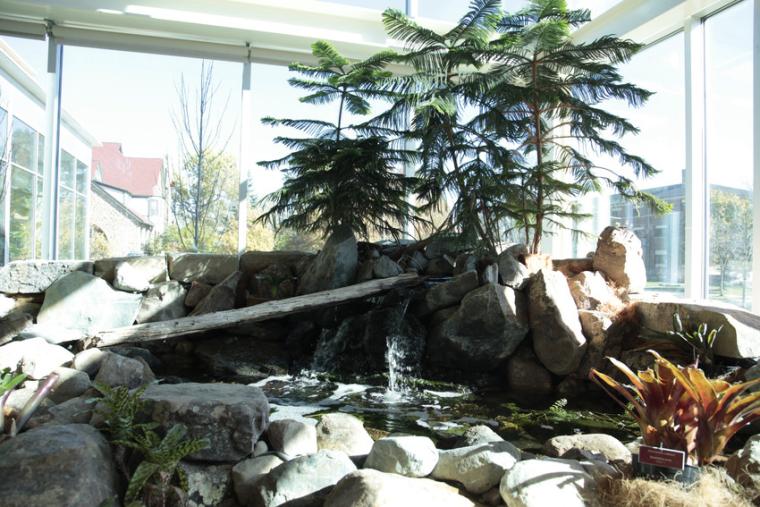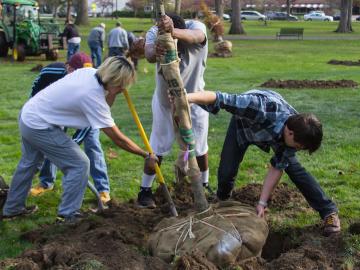Campus News
An Earth Day Q&A with the Office of Environmental Sustainability
May 5, 2015
Ma'Ayan Plaut

On Earth Day 2015, the Office of Environmental Sustainability team answered questions about sustainable practices at home and at work via the Oberlin College Facebook page. Assistant Vice President of Energy Management & Sustainability Meghan Riesterer, Sustainability Coordinator Bridget Flynn, and Sustainable Energy Technology Research Fellow Samuel Hartman contributed to the following responses.
Which one of my everyday objects uses the most water in its entire life cycle?
We'll give a couple different products for comparison. First, we want to mention what "embodied energy" or life cycle is for those who aren't aware. Embodied energy is the sum of all the energy required to produce something as if that energy was incorporated (or embodied) in the product itself. It's basically an accounting method used to find the sum total of the energy necessary for the entire product life cycle.
Now let's talk products! The first one we want to highlight is food products, specifically meat and dairy. A pound of beef takes about 1,600 gallons of water compared to wheat, which is about 100 gallons.
Coincidentally, 1,800 gallons is about the amount of water required just to grow the cotton for a single pair of blue jeans. Thus, OES encourages thrifting and donating and acquiring jeans from the campus Free Store.
A single object with a big water footprint is a car, which comes in at a whopping 39,000 gallons just to manufacture—not counting the oil and car washes!
How many plastic bottles have been saved as counted by the drinking fountains on campus that count each time we fill a reusable bottle? How many of those fountains do we have? Can we have more?
From our tallies, we have 10 Elkay Water Refill Stations on campus. One of these was actually an Ecolympics prize from 2014.
Oberlin banned the sale of bottled water way back in 1999 before we started getting these stations. This was a student initiative. We still have bottles of flavored water, but not plain bottled water. Another water refill station is a prize for this year's Ecolympics, so there will be more! The College will likely continue to install these stations. They are a quick and easy way to get hydrated and to help eliminate plastics.
We don't have the number of total bottles saved marked by the use of the stations, but we would ballpark it to be more than 100,000!
What exactly is the [Johnson] House (J-House) garden?
The J-House Garden is a garden run by the Resource Conservation Team (RCT) at Johnson House. The RCT is the same group that runs the Free Store as well as various other recycling and reuse initiatives. Food scraps from dorms get collected and taken to the J-House garden to be used as compost or soil amendment to grow food. (Does your dorm have a compost captain? If so, that's where your food scraps are going.) The RCT then sells some of its produce to Campus Dining Services (CDS).
What's up with composting at Oberlin?
There are various avenues for organic waste on campus. As we mentioned, dorm compost can go to J-House. Dascomb Hall pre-consumer food scraps go to George Jones Farm. Unfortunately, the business that has been picking up compost from Stevenson Hall, DeCafé, and all Oberlin Student Cooperative Association (OSCA) co-ops went out of business. This was the same place our compost went from the Community & Culture Festival. We are working on solutions in conjunction with the city of Oberlin, Ohio, and the Lorain County Solid Waste Management District.
The city of Oberlin’s Resource Conservation Recovery Commission works on these kinds of issues, and the city adopted a zero waste plan!
With warmer weather on the horizon, what kinds of sustainable activities can we do during the spring and summer?
Spring and summer present many special opportunities for sustainable activities that are much more difficult in the colder months. The first one is going outside! Go play at a park, hike, kayak, or run outside instead of on a treadmill. You can use the outdoors for recreation, but you can also air dry clothes outside and bike and/or walk to your destinations. You can garden and buy local, seasonal produce.
We also recommend a good, therapeutic spring cleaning. Get rid of the stuff that clutters your house and mind. Donate usable items to the Free Store, Goodwill, or your neighbors or friends. In line with spring cleaning, fix that old computer or anything else that needs fixing. If you decide to leave your home over the summer to travel, try driving (or carpooling or taking a train) to your destination instead of flying when possible.
Tags:
You may also like…
This Week in Photos: Sky Rockets
July 9, 2021
Bursts of green, orange, red, and white exploding in a night blue sky serves as inspiration for this week’s photo series.
Who is Joel Baetens?
February 2, 2021
Joel Baetens is an energy engineer who works energy efficient technology into construction projects. He started at Oberlin in January 2020. Find out more about Baetens in this installment of Who Am I?
Oberlin in Photos: The Green Side of Oberlin
April 22, 2020
In recognition of the 50th anniversary of Eary Day, we look back on some of the sustainability programs and milestones that support the college’s commitment to its goal of becoming carbon neutral by 2025.


